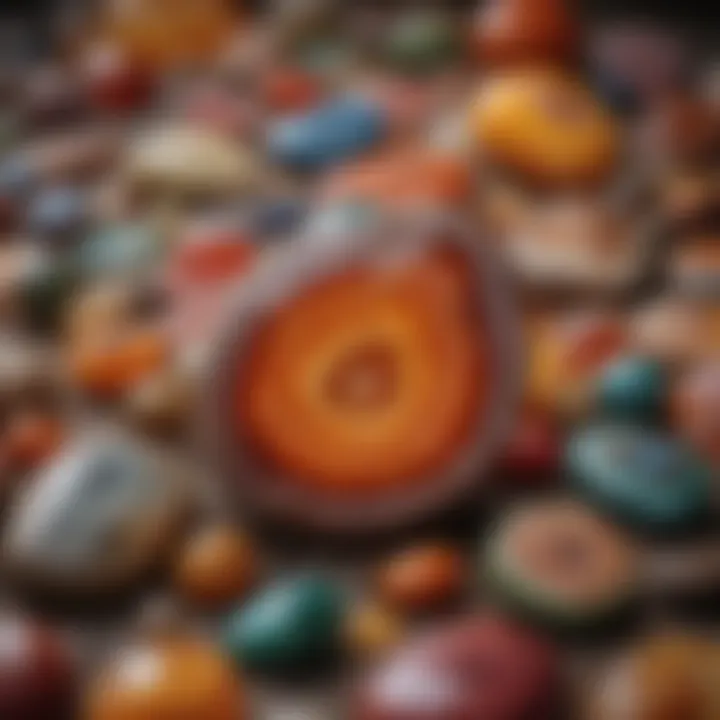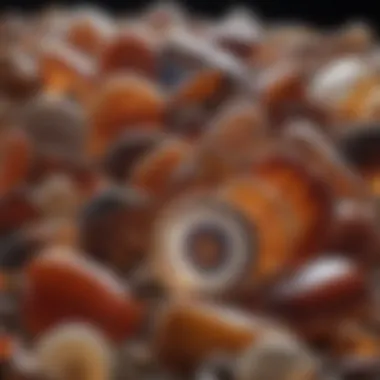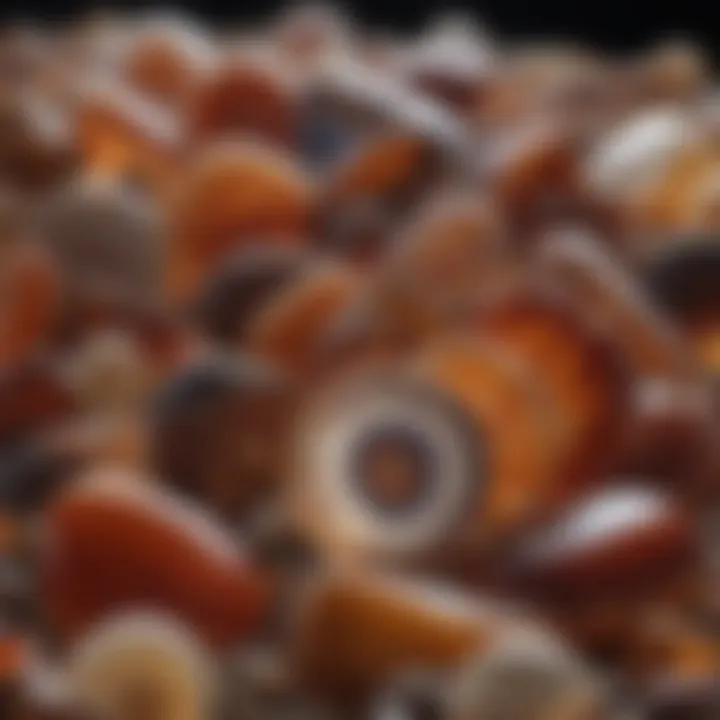Exploring the Varieties of Agate: A Comprehensive Overview


Intro
Agate is more than just a visually appealing mineral; it holds a special place in the hearts of collectors and enthusiasts alike. Known for its distinct patterns and a wide variety of forms, agate is a form of chalcedony that has fascinated both amateur and professional collectors. This article aims to break down the many types of agates found in nature, exploring their unique characteristics, how they form, and their significance in geology and lapidary arts.
Collectors often seek variations based on where the agate is sourced and the patterns it exhibits. This exploration is relevant for anyone looking to deepen their understanding of this captivating mineral and enhance their collection. Whether you are a novice or a seasoned collector, this guide will provide you with insights to appreciate the diversity within the world of agate.
Prolusion to Agate
Agate holds a significant position in the realm of gemstones and geological formations. Understanding agate is crucial for both enthusiasts of the mineral world and collectors. This overview serves as a guide to the characteristics, formation, and varieties of agate. Familiarity with the topic can enhance appreciation for its beauty and its complexities.
Agate, a type of chalcedony, displays distinct banding and color variations. It is not merely a decorative stone; its geological significance is profound. For instance, the processes through which agate forms are indicative of the environmental conditions in which they were created. Collectors often seek specific types due to their unique features and patterns, which can serve as indicators of their origins.
Definition and Characteristics
Let us delve into what defines agate and its essential characteristics. Agate is a subgroup of chalcedony composed primarily of silica. Its structure is primarily cryptocrystalline, which means that crystal formation is too small to be seen with the naked eye. This unique structure allows for the formation of detailed and intricate patterns, which is often the primary appeal of this mineral.
Two primary characteristics to note are its translucency and hardness. Agate displays a variety of colors ranging from blues to reds, greens, and yellows. The patterns that arise may include banding, spots, or swirls. The diverse colors and intricate designs make agate popular not just in jewelry but also in ornamental uses.
The hardness of agate is notable. It typically rates between 6.5 and 7 on the Mohs scale, making it relatively durable. This durability contributes to its use in various applications. Collectors should also take note of its ability to take a good polish, enhancing its aesthetic appeal.
In summary, understanding the definition and characteristics of agate is fundamental. It helps in identifying various types and appreciating their unique features. This knowledge serves as a basis to explore the deeper aspects of agate in the following sections.
Formation of Agate
Understanding the formation of agate is crucial for anyone interested in this beautiful mineral. The processes that lead to the creation of agate are not only fascinating but also impact the physical properties and visual characteristics of the stone. This section aims to provide insights into these geological phenomena, explaining how they contribute to the various types of agate that exist today.
Geological Processes
Agate forms through a series of geological processes that take place over many years. Primarily, agate is a variety of chalcedony, which itself is a microcrystalline form of silica. The formation typically occurs within volcanic rocks or ancient lava flows. The initial stage involves the cooling of molten rock, where silica-rich minerals dissolved in the cooling lava can start to precipitate.
As the lava cools, gas bubbles may get trapped within the rock. Over time, these bubbles can become filled with mineral-rich waters, which play a key role in agate formation. The minerals in these waters will eventually crystallize, leading to the layered appearance that agate is known for. This layering occurs due to fluctuations in temperature, pressure, and the chemical composition of the waters, resulting in the distinctive bands of color and pattern seen in the stone.
"Agate's geological journey is a product of time, pressure, and the delicate balance of chemical reactions."
Role of Water and Silica
Water is an essential component in the formation of agate. Silica is typically dissolved in groundwater, which carries it to the cavities in volcanic rocks or sedimentary layers. As the water moves through the rock, it can deposit silica in layers, resulting in the unique banding patterns observed in different types of agate.
The concentration of silica in the waters will influence the final characteristics of the agate. Higher silica concentration leads to thicker bands, while lower concentrations may produce thinner, more delicate layers. The interaction between water and silica also affects the color variations present in agate; impurities like iron or manganese can impart different shades to the layers as the silica crystallizes.
Types of Agate
Agate is a mineral that showcases extraordinary variety in its appearance and composition. Understanding the types of agate is essential for several reasons. First, each type displays unique characteristics, which can affect its desirability and value among rock and fossil collectors. Secondly, recognizing these variations allows enthusiasts to appreciate the beauty and complexity of this mineral. Lastly, learning about the various agate forms can help inform decisions when purchasing or collecting agate specimens.
Banded Agate


Banded agate is one of the most recognized types of agate. It exhibits distinct, parallel bands of different colors. These bands are the result of variations in mineral composition during deposition. Banded agate can be found in many colors, including blue, white, and red. Collectors often seek it for its striking appearance and the intricate patterns formed within it. Its banding often suggests intriguing geological histories which make it even more prized among collectors.
Moss Agate
Moss agate tends to have a more organic appearance. This stone is characterized by its green and brown hues that resemble moss, often set against a cloudy or translucent background. The flecks and swirls in moss agate are thought to be caused by the inclusion of iron and manganese. This type of agate is particularly valued in jewelry making, as its unique patterns can be mesmerizing. Collectors appreciate moss agate not only for its beauty but also for the botanical essence it evokes.
Dendritic Agate
Dendritic agate is notable for its tree-like inclusions, which resemble delicate branches or foliage. These formations are often due to the presence of manganese or iron. The contrast between the dark dendrites and the lighter agate matrix creates a stunning visual effect that draws collectors. It is often seen as a symbol of growth and fertility, making it a popular choice for those interested in the metaphysical aspects of stones.
Fire Agate
Fire agate is captivating due to its iridescent play of colors. This occurs when light reflects off layers of the stone, creating a spectrum of colors that can include red, orange, and blue. Unlike many agates that are layered, fire agate displays its colors in a three-dimensional manner, which adds depth. It is sought after by collectors interested in unique visual phenomena, and it is also believed to have protective properties, enhancing its appeal.
Blue Lace Agate
Blue lace agate features soft, light blue layers that give it a serene appearance. The banding in blue lace agate is fine and delicate, resembling lace, hence its name. This type is predominantly used in jewelry, due to its gentle hues and lightweight nature. Collectors appreciate blue lace agate for its calming qualities and its ability to blend well with other stones, making it versatile.
Crazy Lace Agate
Crazy lace agate is known for its chaotic patterns of swirling colors, which can include red, yellow, and white. No two specimens are alike, making it a favorite for collectors seeking variety. The unique designs found in crazy lace agate create an appealing aesthetic that can be used in various decorative items and jewelry. This variety symbolizes joy and laughter, contributing to its popularity in the metaphysical community.
Black Agate
Black agate is a powerful and intriguing type of agate. Its deep black coloring can range from opaque to translucent and often showcases bands or spots of white or gray. The simplicity of black agate appeals to many collectors, and it is used in a variety of jewelry pieces. Additionally, it is often associated with grounding and strength, adding a layer of significance for many enthusiasts.
Green Agate
Green agate is characterized by its soothing green tones, sometimes layered with lighter shades. This type is often used in decorative items as it is believed to promote healing and emotional balance. Collectors are drawn to green agate for its natural beauty and calming aura. Its availability in various forms, including tumbled stones and rough specimens, makes it accessible to a wide audience.
Understanding these types of agate enables collectors to make informed choices, appreciate the mineral's complexity, and enjoy its diverse beauty.
Knowing the varied types of agate enhances collector's experiences and fosters a deeper connection to this fascinating mineral.
Agate's Aesthetic Appeal
Agate's aesthetic appeal is a significant aspect that draws collectors and enthusiasts alike. The mineral not only captivates the eye with its colors and patterns, but it also embodies the geological history and natural processes behind its creation. The appeal of agate lies in how each piece is unique, showcasing the different variables involved in its formation. Furthermore, its versatility allows it to fit seamlessly into various applications such as jewelry, home décor, and even artistic works.
Color Variations
One of the most striking features of agate is its vast array of color variations. From deep reds and serene blues to vibrant greens and earthy browns, agate presents a palette that can cater to any aesthetic preference. This diversity is primarily due to the presence of different minerals during the formation process. For instance, iron can impart reddish hues, while copper might lend a blue tone. The color intensity and distribution can influence both the value and demand for specific pieces among collectors.
Moreover, the variation in color often affects whether collectors prefer certain types over others for specific applications. For example, the serene blue tones found in Blue Lace Agate are favored for calming spaces, while the fiery reds in Fire Agate appeal to those seeking warmth in their collections.
Pattern Diversity
In addition to color, pattern diversity is another hallmark of agate’s aesthetic allure. The banding, speckling, and swirling patterns create visual interest and individuality in each specimen. Banded Agate displays striking layers, captivating the viewer with its geometric precision. Moss Agate, on the other hand, features unique inclusions resembling natural landscapes, appealing to those with a penchant for the organic.


The significance of patterns also extends to the symbolic meanings attributed to various types of agate. Some believe that these patterns can influence the properties of the stone, heightening its metaphysical attributes. > "The myriad patterns not only beautify agate but also tell stories of the circumstances surrounding its formation."
Uses and Applications
The realm of agate extends far beyond mere aesthetic appreciation. Its versatility results in various applications that span practical domains like jewelry-making, interior design, and even metaphysical practices. Understanding these uses allows enthusiasts and collectors to appreciate not only the beauty of agate but also its multifaceted contributions to both art and utility. The range of applications highlights the mineral's significance as more than just a decorative piece; it showcases its role in enhancing personal expression and well-being.
Jewelry Making
Agate is a popular choice in jewelry-making due to its varied colors and patterns. Artisans use it in pendants, earrings, and bracelets, taking advantage of its unique banded designs. The hardness of agate, rated a 7 on the Mohs scale, makes it suitable for intricate designs and ensures durability. When crafted into pieces, agate can elevate any outfit while providing a touch of natural elegance.
When selecting agate for jewelry, individuals often consider the specific type of agate they wish to use. For instance, Blue Lace Agate has a calming blue hue that appeals to those seeking a tranquil aesthetic. In contrast, Fire Agate, with its fiery colors, offers a more dramatic choice. This variety enables artisans to cater to a wide range of tastes and styles. Furthermore, the gemstone is often combined with various metal settings, enhancing its visual allure and making each piece unique.
Interior Design
In the context of interior design, agate serves as a stunning decorative element. The mineral can be used as coasters, table tops, or wall art, providing an exclusive touch to living spaces. The rich colors and varied patterns can complement different design styles, from modern minimalism to bohemian chic.
One primary aspect to consider is the natural light. When placed strategically, agate can reflect light beautifully, creating unique color variations throughout the day. Designers often favor using polished agate slices in furniture or as inlays because of their visual appeal and durability. Introducing agate into home decor not only adds visual interest but also connects the space to the natural world.
Healing and Metaphysical Properties
Agate is also associated with various healing and metaphysical properties, making it a focal point for alternative practices. Many believe that agate can promote emotional healing, stability, and balance. Practitioners often use agate during meditation or energy healing sessions, claiming the stone enhances the flow of positive energy.
Different types of agate are thought to possess distinct properties. For example, Moss Agate is often said to encourage growth and new beginnings, while Dendritic Agate is believed to bring tranquility and clear thoughts. Many collectors embrace these interpretations, incorporating the stones into their lives not only for beauty but also for the potential benefits they may offer.
"Agate is more than just a pretty stone; it is a conduit of balance and harmony in a turbulent world."
In summary, the uses and applications of agate reveal its broad appeal. From artistic expressions in jewelry to enhancing living spaces and promoting well-being, agate serves multiple roles in both practical and aesthetic dimensions. This depth adds value, making agate not just a material but a certified entity in art, home design, and holistic practices.
How to Identify Various Agate Types
Identifying different types of agate is essential for both collectors and enthusiasts. Each variety has unique features that can enhance their value and appeal. Knowing how to properly identify agate types enables collectors to make informed decisions when purchasing, trading, or studying specimens. Moreover, being able to distinguish between varieties can deepen one’s appreciation for the complexity and beauty of agates.
Visual Identification Techniques
Visual identification of agate varieties involves examining color, pattern, and texture closely. Some key factors include:
- Color: Agates display a wide spectrum of colors ranging from subtle pastels to vibrant hues. Fire agate exhibits reds and oranges, while Blue Lace Agate features soft blues. Identifying dominant colors and any variations is crucial.
- Patterning: The bands and patterns in agate can provide crucial clues. Banded agate shows distinct layers. Moss agate, on the other hand, has dendritic inclusions resembling moss. Carefully observing these features can lead to accurate identification.
- Transparency: Different agate types exhibit varying levels of transparency. For instance, Black Agate is generally opaque, whereas some types of banded agate can be translucent.
- Surface Finish: The polish on the stone can also be a factor for identification. Glossy surfaces tend to reflect light better, which can be an indicator of treatment or natural finish.
After carefully analyzing these aspects, it is possible to create a mental checklist for identification, streamlining the process when confronted with various specimens.
Testing Hardness and Other Properties
Testing hardness and other physical properties can further confirm agate types, which is critical when visual cues are not sufficient. The Mohs hardness scale is commonly used in mineralogy to assess the hardness of a stone.
- Hardness Test: Agate generally ranges between 6.5 to 7 on the Mohs scale. Utilize a scratch test with common items like a copper coin or a steel nail to gently scratch the surface of the agate. If it scratches easily, it may indicate the stone is not genuine agate.
- Specific Gravity: Weighing the specimen in air and then again submerged in water can help determine its specific gravity. This measurement can help distinguish agate from other similar minerals.
- Acid Test: A small drop of dilute hydrochloric acid can reveal if the stone is a true agate or another mineral. Agate will not react with dilute acid, while calcite will fizz.
"Identifying agate varieties requires both keen observation and practical testing, enhancing the collector’s understanding of their specimens."


In summary, a solid approach combines visual cues with practical tests. Properly identifying agate types not only enriches the collector's experience but also adds value to their collection.
Care and Preservation of Agate
Caring for and preserving agate is essential for maintaining its beauty and longevity. Agate, like many gemstones, can be sensitive to environmental factors. Without proper care, it may lose its luster and charm. This section will explain the importance of cleaning methods and storing tips that can help rock and fossil collectors maintain their agate specimens.
Cleaning Methods
Regular cleaning is vital to preserve the quality of agate. Dust, dirt, and oils from handling can accumulate, diminishing its appeal. Here are some effective cleaning methods:
- Gentle Soap and Water: Use a mild soap mixed with lukewarm water. Dip a soft cloth into the solution and gently wipe the stone. Avoid harsh chemicals as they can damage the surface.
- Soft Brush: For intricate designs, use a soft brush to clean. This can help reach tight spaces where dirt may gather.
- Avoid Ultrasonic Cleaners: While effective for some stones, ultrasonic cleaners can be harmful to agate, potentially leading to cracks or color loss.
- Drying: After cleaning, dry the agate with a soft, lint-free cloth. Ensure it is completely dry before storing to prevent moisture retention.
Regular cleaning enhances the visual appeal of the agate and allows the owner to appreciate its natural intricacies more clearly.
Storing Tips
Storing agate correctly is just as crucial as cleaning it. Proper storage protects these beautiful stones from scratches and damage. Consider the following tips:
- Soft Pouches: Use padded pouches or soft cloth when storing individual pieces. This will prevent them from knocking against hard surfaces.
- Avoid Direct Sunlight: Prolonged exposure to sunlight can fade the colors of agate. Store it in a cool, dark place to maintain its hue.
- Separate Containers: If you have multiple pieces, consider storing them in separate containers. This reduces the risk of scratches that can occur when stones are packed closely together.
- Humidity Control: Store agate in a relatively dry environment. Excess humidity can lead to mold or other issues.
By following these care and preservation guidelines, collectors can ensure that their agate remains in excellent condition, preserving both its aesthetic and financial value for years to come.
Cultural Significance of Agate
Agate holds substantial cultural significance across various civilizations and eras. This chapter aims to explore its historical roots and modern meanings, showcasing how agate transcends mere aesthetic value to embody deeper symbolic and spiritual implications. For rock and fossil collectors, understanding the cultural backdrop of agate enriches the appreciation for this mineral, linking it to human history and belief systems.
Historical Perspectives
Throughout history, agate has been revered by many cultures. In ancient Rome, it was believed that agate could protect against storms and enhance courage. The use of agate in jewelry and amulets was widespread, often thought to provide spiritual benefits to the wearer. Additionally, Egyptians utilized agate in burial artifacts, thinking it would ensure safe passage to the afterlife.
In Chinese tradition, agate symbolizes harmony and balance. Collectors may find the historical use of agate as a talisman fascinating, as it not only represents individual belief but also societal values of different times. The ancient Sumerians, too, crafted intricate seals from agate, highlighting its value as an artistic medium and a tool of commerce. Such historical perspectives enrich the narrative of agate, illustrating how people have utilized its beauty and believed in its powers for thousands of years.
Modern Interpretations
Today, agate continues to hold significance in contemporary spiritual and aesthetic practices. Many modern practitioners of crystal healing consider agate a grounding stone. It is thought to stabilize energy and promote calmness. This interpretation resonates with those who seek peace in their fast-paced lives. Items like agate coasters or decorative pieces are popular in interior design, reflecting a blend of nature and modern aesthetics.
Furthermore, in our increasingly digital world, people often turn to the natural beauty of agate for inspiration and grounding. It's no longer just a mineral; it represents a connection to nature amidst technological advancements. Agate's multi-layered textures and colors evoke a sense of wonder, compelling collectors to appreciate both its physical and metaphysical properties.
"Agate is not merely a stone; it is a link to our cultural heritage, reflecting human aspiration and creativity through the ages."
Recognizing the cultural significance of agate helps collectors and enthusiasts appreciate it beyond the physical attributes. It invites an understanding of how this mineral has interwoven itself into the fabric of human history and continues to inspire modern interpretations.
Culmination
The conclusion of this article serves as a critical component, tying together the wealth of information presented regarding agate. Throughout the sections, we explored the various types of agate, their aesthetic qualities, and their practical applications. It is essential to recognize that agate is not merely a visually stunning mineral; its geological and cultural significance adds layers of value that collectors and enthusiasts should appreciate.
Summary of Key Points
- Types of Agate: This includes banded, moss, dendritic, fire, blue lace, crazy lace, black, and green agates. Each of these types has unique characteristics that contribute to its appeal.
- Aesthetic Appeal: The vast range of colors and patterns found in agate enhances its desirability. Collectors often seek specific visual traits that make each piece unique.
- Uses: Agate is utilized in jewelry making, interior design, and even in metaphysical practices, demonstrating its versatility.
- Identification: Distinguishing between different types of agate involves both visual techniques and practical tests that assess hardness and other properties.
- Care: Proper cleaning and storage methods ensure the longevity of agate collections.
- Cultural Significance: Agate has held historical significance in various cultures, and its modern interpretations continue to expand its relevance.
Final Thoughts
Engaging with agate goes beyond mere collection; it invites a deeper exploration of geological processes and human history. Collectors hold a piece of the Earth's history in their hands when they choose agate specimens. It presents opportunities for education about minerals and the earth's processes. For those invested in rock and fossil collecting, understanding the nuances of agate deepens appreciation and can enhance the value of their collections. As you continue to explore this mineral, take note of the stunning variety agate offers and consider the stories they tell from their formation to their place in contemporary culture.



